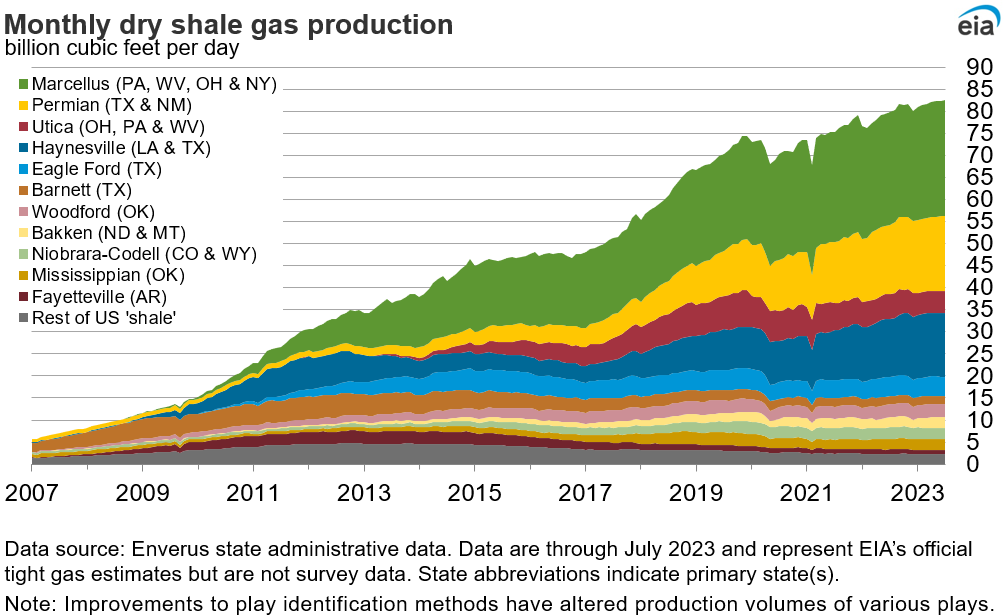In the News:
The United States exported a record volume of natural gas in the first half of 2023
The United States exported more natural gas in the first six months of 2023 than in any other previous six-month period, averaging 12.5 billion cubic feet per day (Bcf/d), 11% (1.3 Bcf/d) more than in the same period in 2022, according to our Natural Gas Monthly. In May, U.S. net natural gas exports as liquefied natural gas (LNG) and by pipeline averaged a monthly record high of 13.6 Bcf/d. In 2017, the United States became a net exporter of natural gas (natural gas exports exceeded natural gas imports) for the first time since 1957, primarily because of increased LNG exports.
Growth in LNG exports from the Lower 48 states, which started in 2016 when Sabine Pass LNG—the first LNG export terminal in the Lower 48 states—came online, has led to increased U.S. natural gas exports. In the first half of 2023 (1H23), U.S. LNG exports averaged 11.6 Bcf/d, making the United States the world’s top LNG exporting country. U.S. LNG exports in 1H23 were up 4% (0.5 Bcf/d) compared with a year ago, despite declining in May and June.
In 1H23, U.S. natural gas pipeline exports, which go to both Canada and Mexico, averaged 8.8 Bcf/d, or 4% (0.3 Bcf/d) more than in 1H22. U.S. natural gas exports by pipeline to Mexico reached a monthly high of 6.8 Bcf/d in June and accounted for about 66% of total U.S. pipeline exports from January through June. Mexico increased its natural gas imports from the United States in 1H23 to meet electric power sector demand, which has been increasing since 2018. Since 2019, natural gas pipeline exports from West Texas to Mexico have grown steadily as more connecting pipelines in Central and Southwest Mexico have been placed in service.
U.S. LNG imports averaged less than 0.1 Bcf/d in 1H23. Almost all LNG imports are delivered into the New England market and can be a key marginal source of supply during periods of high demand, particularly in the winter months of December through February. Warmer-than-average temperatures in the Northeast in the first quarter of 2023 contributed to lower LNG imports compared with the same time in 2022.
U.S. natural gas imports by pipeline, which are primarily from Canada, declined by 5% (0.4 Bcf/d) in 1H23 compared with a year ago. Imports from Canada help support seasonal fluctuations in consumption in the United States and generally peak in January or February, with a smaller peak in the summer months. A mild winter, combined with wildfires in Western Canada that disrupted natural gas deliveries to the United States this spring, contributed to lower natural gas imports in 1H23 compared with 1H22.
Market Highlights:
(For the week ending Wednesday, September 6, 2023)Prices
- Henry Hub spot price: The Henry Hub spot price remained flat at $2.49 per million British thermal units (MMBtu) yesterday compared with last Wednesday.
- Henry Hub futures price: The price of the October 2023 NYMEX contract decreased 28.6 cents, from $2.796/MMBtu last Wednesday to $2.510/MMBtu yesterday. The price of the 12-month strip averaging October 2023 through September 2024 futures contracts declined 13.8 cents to $3.208/MMBtu. The NYMEX January 2024 contract reflects about a $1.17/MMBtu premium to the October 2023 contract.
- Select regional spot prices: Natural gas spot prices fell at most locations this report week (Wednesday, August 30 to Wednesday, September 6), except in the Northeast. Price changes this week ranged from a decrease of $0.77/MMBtu at PG&E Citygate to an increase of $1.12/MMBtu at Algonquin Citygate.
- Prices across the West decreased this report week. The price at PG&E Citygate in Northern California fell 77 cents, down from $4.51/MMBtu last Wednesday to $3.74/MMBtu yesterday, and the price at SoCal Citygate in Southern California decreased 63 cents from $3.71/MMBtu last Wednesday to $3.08/MMBtu yesterday. Natural gas consumption in the electric power sector in the Western region decreased by 20%, or 1.2 billion cubic feet per day (Bcf/d), this week, according to S&P Global Commodity Insights (SPGCI). More than half of the decline in electric power consumption (0.7 Bcf/d) occurred in California. Temperatures in the Riverside Area, east of Los Angeles, averaged 75°F this week, resulting in 73 cooling degree days (CDD), 56 fewer CDDs than last week and 26 fewer than normal.
- In the Desert Southwest, the price at the El Paso South Mainline/North Baja pricing point for deliveries from the Permian Basin into Arizona and western New Mexico decreased 80 cents this report week, down from $3.42 last Wednesday to $2.62/MMBtu yesterday, reflecting cooler temperatures and decreased air-conditioning demand in the region. In the Phoenix Area, temperatures averaged 91°F this report week, 11°F below last week’s average of 102°F. The lower average temperatures resulted in 185 CDDs this week, 74 fewer CDDs than last week and 9 fewer than normal. Natural gas consumption in the electric power sector in the Desert Southwest decreased 15% (0.4 Bcf/d) week over week, according to data from SPGCI.
- In the Northeast, at Algonquin Citygate, which serves Boston-area consumers, the price went up $1.12 from $1.43/MMBtu last Wednesday to $2.55/MMBtu yesterday. In the Boston Area, temperatures averaged 72°F this week, resulting in 52 CDDs, 16 more than last week and 15 CDDs more than normal. At the Transcontinental Pipeline Zone 6 trading point for New York City, the price increased 78 cents from $1.35/MMBtu last Wednesday to $2.13/MMBtu yesterday. Temperatures in the New York-Central Park Area averaged 77°F, which resulted in 84 CDDs, 16 CDDs more than last week. Above-average temperatures led to increased demand for air conditioning, and as a result natural gas consumption in the electric power sector in the Northeast rose 5.0% (0.5 Bcf/d) this week, according to data from SPGCI.
- International futures prices: International natural gas futures prices decreased this report week. According to Bloomberg Finance, L.P., weekly average front-month futures prices for liquefied natural gas (LNG) cargoes in East Asia decreased 7 cents to a weekly average of $13.26/MMBtu. Natural gas futures for delivery at the Title Transfer Facility (TTF) in the Netherlands decreased 46 cents to a weekly average of $10.75/MMBtu. In the same week last year (week ending September 7, 2022), the prices were $56.07/MMBtu in East Asia and $66.49/MMBtu at TTF.
- Natural gas plant liquids (NGPL) prices: The natural gas plant liquids composite price at Mont Belvieu, Texas, rose by 35 cents/MMBtu, averaging $7.51/MMBtu for the week ending September 6. Weekly average ethane prices rose 3%, following natural gas prices at the Houston Ship Channel, which rose 2% week over week, widening the ethane premium to natural gas by 4%. Ethylene spot prices rose 6%, widening the ethylene premium to ethane by 10%. The average weekly Brent crude oil price rose 5%, resulting in increased prices of other natural gas liquids. The propane price rose 7%, widening the propane discount relative to crude oil by 4%. The normal butane price rose 5%, the isobutane price rose 1%, and the natural gasoline price rose 6%.
Daily spot prices by region are available on the EIA website.
Supply and Demand
- Supply: According to data from SPGCI, the average total supply of natural gas fell by 0.5% (0.6 Bcf/d) compared with the previous report week. Dry natural gas production decreased by 0.4% (0.4 Bcf/d) to average 102.2 Bcf/d, and average net imports from Canada decreased by 3.5% (0.2 Bcf/d) from last week.
- Demand: Total U.S. consumption of natural gas fell by 3.9% (2.9 Bcf/d) compared with the previous report week, according to data from SPGCI. Most of the decrease was due to a 7.1% (3.2 Bcf/d) week-over-week reduction in natural gas use for power generation. Industrial sector consumption increased by 0.3% (0.1 Bcf/d) and residential and commercial sector consumption increased by 2.5% (0.2 Bcf/d). Natural gas exports to Mexico were essentially unchanged this week. Natural gas deliveries to U.S. LNG export facilities (LNG pipeline receipts) averaged 13.0 Bcf/d, or 0.9 Bcf/d higher than last week.
Liquefied Natural Gas (LNG)
- Pipeline receipts: Average natural gas deliveries to U.S. LNG export terminals increased by 7.1% (0.9 Bcf/d) week over week, averaging 13.0 Bcf/d, the highest weekly average since May, according to data from SPGCI. Natural gas deliveries to terminals in South Louisiana increased by 8.0% (0.6 Bcf/d) to 7.8 Bcf/d, while deliveries to terminals in South Texas increased by 6.4% (0.2 Bcf/d) to 4.1 Bcf/d. Natural gas deliveries to terminals outside the Gulf Coast were essentially unchanged at 1.0 Bcf/d.
- Vessels departing U.S. ports: Twenty-six LNG vessels (nine from Sabine Pass; four each from Corpus Christi and Freeport; three from Calcasieu Pass; and two each from Cameron, Cove Point, and Elba Island) with a combined LNG-carrying capacity of 96 Bcf departed the United States between August 31 and September 6, according to shipping data provided by Bloomberg Finance, L.P.
Rig Count
- According to Baker Hughes, for the week ending Tuesday, August 29, the natural gas rig count decreased by 1 rig from a week ago to 114 rigs, as the Marcellus dropped 1 rig. The number of oil-directed rigs was unchanged from a week ago at 512 rigs, although there were changes within the producing regions. The Eagle Ford dropped two rigs, and the Arkoma Woodford and the Permian dropped one rig each, while the Cana Woodford and the DJ-Niobrara added one rig each, and two rigs were added among unidentified producing basins. The total rig count, which includes 5 miscellaneous rigs, stands at 631 rigs, 129 fewer rigs than last year at this time.
Storage
- Net injections into storage totaled 33 Bcf for the week ending September 1, compared with the five-year (2018–2022) average net injections of 60 Bcf and last year's net injections of 55 Bcf during the same week. Working natural gas stocks totaled 3,148 Bcf, which is 222 Bcf (8%) more than the five-year average and 462 Bcf (17%) more than last year at this time.
- According to The Desk survey of natural gas analysts, estimates of the weekly net change to working natural gas stocks ranged from net injections of 31 Bcf to 58 Bcf, with a median estimate of 41 Bcf.
- The average rate of injections into storage is 5% lower than the five-year average so far in the refill season (April through October). If the rate of injections into storage matched the five-year average of 11.1 Bcf/d for the remainder of the refill season, the total inventory would be 3,817 Bcf on October 31, which is 222 Bcf higher than the five-year average of 3,595 Bcf for that time of year.
See also:
Top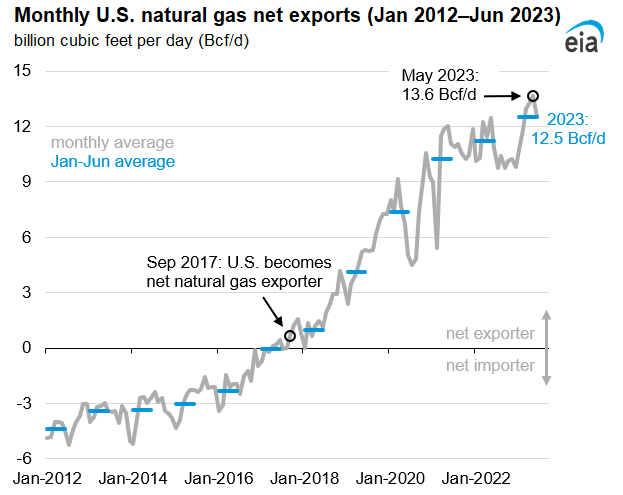 Data source: U.S. Energy Information Administration,
Natural Gas Monthly
Data source: U.S. Energy Information Administration,
Natural Gas MonthlyNote: Net exports=gross exports (liquefied natural gas (LNG) + pipeline) minus gross imports (LNG + pipeline).
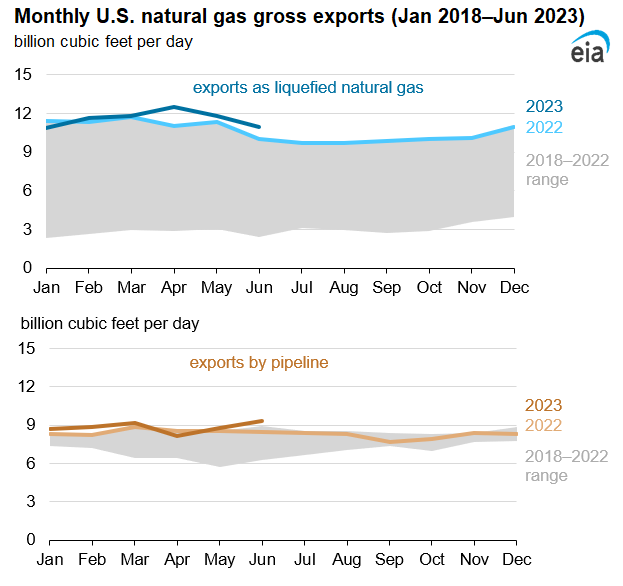 Data source: U.S. Energy Information Administration,
Natural Gas Monthly
Data source: U.S. Energy Information Administration,
Natural Gas Monthly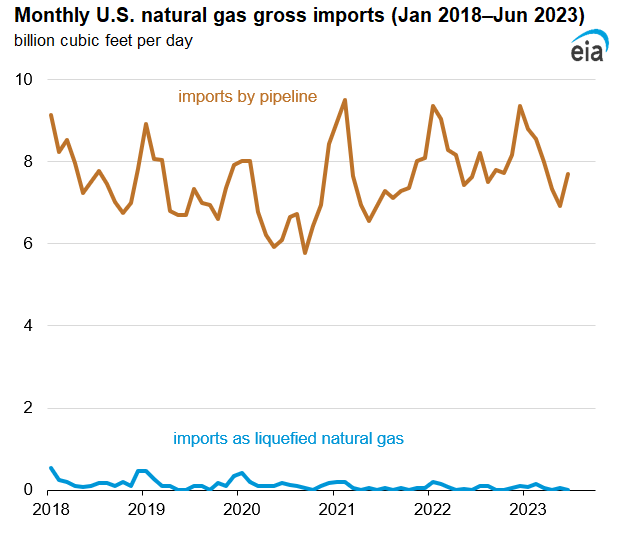 Data source: U.S. Energy Information Administration,
Natural Gas Monthly
Data source: U.S. Energy Information Administration,
Natural Gas Monthly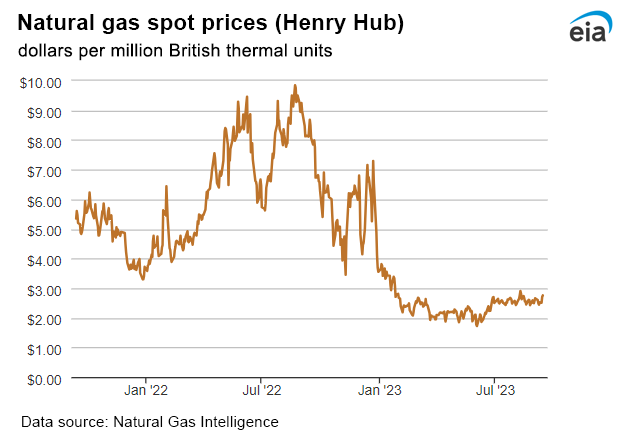
| Spot Prices ($/MMBtu) | Thu, 07-Sep |
Fri, 08-Sep |
Mon, 11-Sep |
Tue, 12-Sep |
Wed, 13-Sep |
|---|---|---|---|---|---|
| Henry Hub |
2.45 |
2.52 |
2.51 |
2.71 |
2.76 |
| New York |
1.96 |
1.59 |
1.77 |
1.73 |
1.69 |
| Chicago |
2.28 |
2.31 |
2.33 |
2.36 |
2.34 |
| Cal. Comp. Avg.* |
3.16 |
3.14 |
3.45 |
3.55 |
3.56 |
| Futures ($/MMBtu) | |||||
| October contract | 2.579 |
2.605 |
2.608 |
2.743 |
2.680 |
| November contract |
2.958 |
2.966 |
2.937 |
3.015 |
2.987 |
| *Avg. of NGI's reported prices for: Malin, PG&E Citygate, and Southern California Border Avg. | |||||
| Data source: NGI's Daily Gas Price Index | |||||
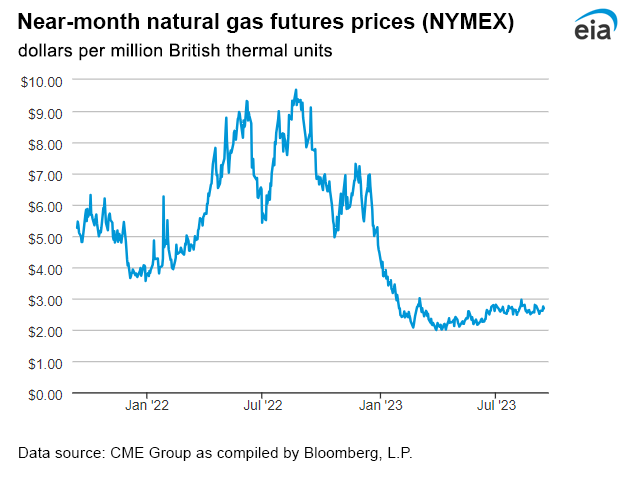
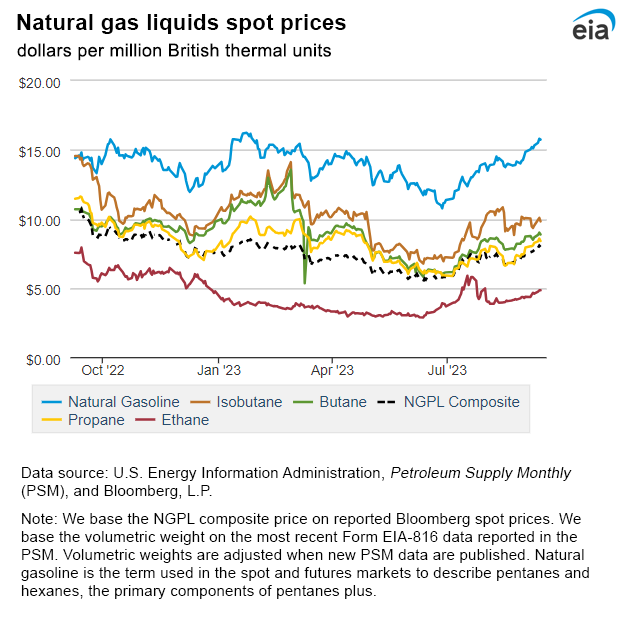
| U.S. natural gas supply - Gas Week: (9/7/23 - 9/13/23) | |||
|---|---|---|---|
Average daily values (billion cubic feet) |
|||
this week |
last week |
last year |
|
| Marketed production | 115.0 |
115.4 |
113.8 |
| Dry production | 101.9 |
102.2 |
100.4 |
| Net Canada imports | 5.4 |
5.6 |
5.3 |
| LNG pipeline deliveries | 0.1 |
0.1 |
0.1 |
| Total supply | 107.3 |
107.9 |
105.8 |
|
Data source: S&P Global Commodity Insights | |||
| U.S. natural gas consumption - Gas Week: (9/7/23 - 9/13/23) | |||
|---|---|---|---|
Average daily values (billion cubic feet) |
|||
this week |
last week |
last year |
|
| U.S. consumption | 72.3 |
72.3 |
69.6 |
| Power | 42.0 |
42.1 |
40.2 |
| Industrial | 21.8 |
21.6 |
21.5 |
| Residential/commercial | 8.5 |
8.6 |
7.8 |
| Mexico exports | 6.5 |
6.6 |
5.6 |
| Pipeline fuel use/losses | 6.9 |
7.0 |
6.7 |
| LNG pipeline receipts | 12.1 |
13.0 |
11.2 |
| Total demand | 97.8 |
98.8 |
93.1 |
|
Data source: S&P Global Commodity Insights | |||
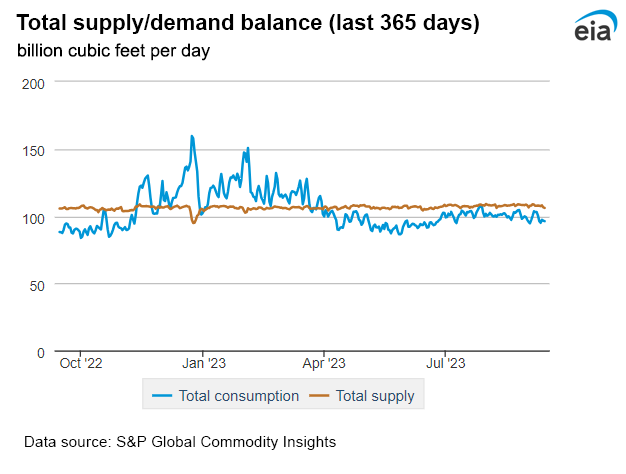
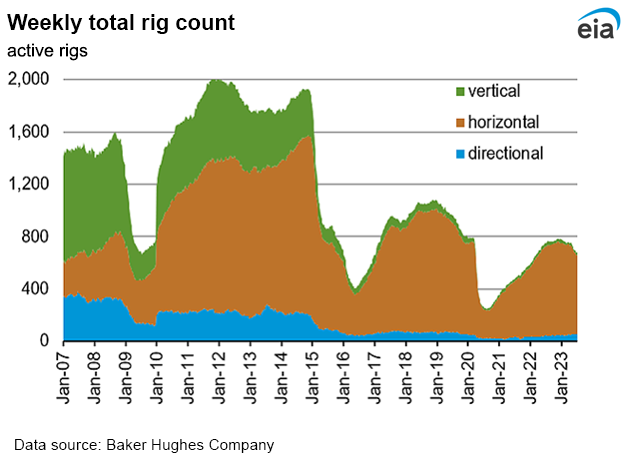
| Rigs | |||
|---|---|---|---|
Tue, September 05, 2023 |
Change from |
||
last week |
last year |
||
| Oil rigs | 513 |
0.2% |
-13.2% |
| Natural gas rigs | 113 |
-0.9% |
-31.9% |
| Note: Excludes any miscellaneous rigs | |||
| Rig numbers by type | |||
|---|---|---|---|
Tue, September 05, 2023 |
Change from |
||
last week |
last year |
||
| Vertical | 14 |
0.0% |
-41.7% |
| Horizontal | 562 |
-0.7% |
-18.8% |
| Directional | 56 |
9.8% |
30.2% |
| Data source: Baker Hughes Company | |||
| Working gas in underground storage | ||||
|---|---|---|---|---|
Stocks billion cubic feet (Bcf) |
||||
| Region | 2023-09-08 |
2023-09-01 |
change |
|
| East | 775 |
766 |
9 |
|
| Midwest | 904 |
877 |
27 |
|
| Mountain | 225 |
218 |
7 |
|
| Pacific | 260 |
252 |
8 |
|
| South Central | 1,041 |
1,035 |
6 |
|
| Total | 3,205 |
3,148 |
57 |
|
|
Data source: U.S. Energy Information Administration Form EIA-912, Weekly Underground Natural Gas Storage Report
Note: Totals may not equal sum of components because of independent rounding. | ||||
| Working gas in underground storage | |||||
|---|---|---|---|---|---|
Historical comparisons |
|||||
Year ago (9/8/22) |
5-year average (2018-2022) |
||||
| Region | Stocks (Bcf) |
% change |
Stocks (Bcf) |
% change |
|
| East | 657 |
18.0 |
725 |
6.9 |
|
| Midwest | 804 |
12.4 |
851 |
6.2 |
|
| Mountain | 162 |
38.9 |
185 |
21.6 |
|
| Pacific | 235 |
10.6 |
262 |
-0.8 |
|
| South Central | 902 |
15.4 |
978 |
6.4 |
|
| Total | 2,760 |
16.1 |
3,002 |
6.8 |
|
| Data source: U.S. Energy Information Administration Form EIA-912, Weekly Underground Natural Gas Storage Report
Note: Totals may not equal sum of components because of independent rounding. |
|||||
| Temperature – heating & cooling degree days (week ending Sep 07) | ||||||||
|---|---|---|---|---|---|---|---|---|
HDDs |
CDDs |
|||||||
| Region | Current total |
Deviation from normal |
Deviation from last year |
Current total |
Deviation from normal |
Deviation from last year |
||
| New England | 5 |
-7 |
-4 |
46 |
33 |
35 |
||
| Middle Atlantic | 2 |
-5 |
1 |
50 |
25 |
15 |
||
| E N Central | 5 |
-8 |
2 |
52 |
27 |
15 |
||
| W N Central | 6 |
-12 |
0 |
65 |
31 |
18 |
||
| South Atlantic | 0 |
-1 |
0 |
87 |
13 |
-1 |
||
| E S Central | 0 |
-1 |
0 |
84 |
18 |
8 |
||
| W S Central | 0 |
-1 |
0 |
136 |
35 |
37 |
||
| Mountain | 7 |
-14 |
7 |
46 |
-5 |
-40 |
||
| Pacific | 4 |
-4 |
3 |
17 |
-19 |
-80 |
||
| United States | 3 |
-6 |
1 |
64 |
16 |
-3 |
||
|
Data source: National Oceanic and Atmospheric Administration Note: HDDs=heating degree days; CDDs=cooling degree days | ||||||||
Average temperature (°F)
7-day mean ending Sep 07, 2023
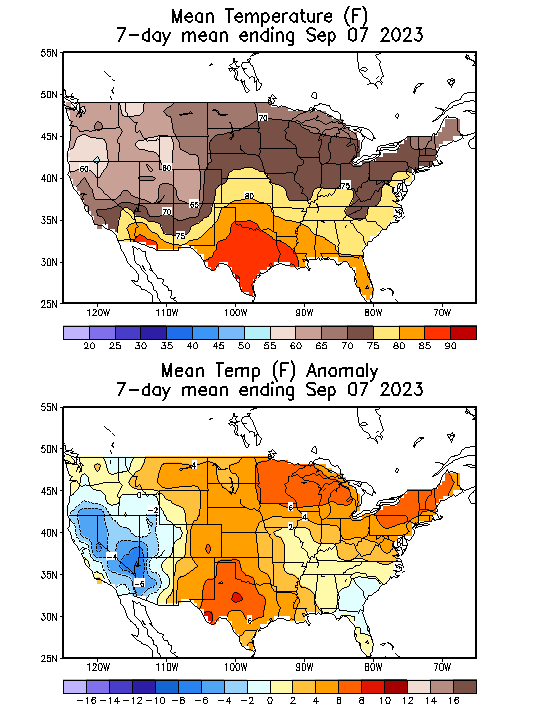
Data source: National Oceanic and Atmospheric Administration
Deviation between average and normal temperature (°F)
7-day mean ending Sep 07, 2023

Data source: National Oceanic and Atmospheric Administration

